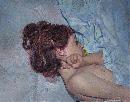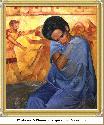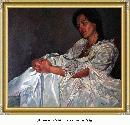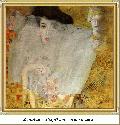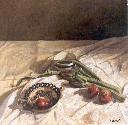EXISTENTIAL DIMENSION IN
LORENZO ANTOGNETTI’S NEW FIGURATION
-FIGURATIVENESS AS EVOCATION OF A CIVILIZATION OF IMAGES -
by William Tode
If we want to take the comprehension of Lorenzo Antognetti’s work over the happy intuition, we have to go back very far.
It was Ernest Cassirer, “the philosophy of the symbolic shapes (forms)” in 1931, to gather the beginning of the artiste expression, for differentiation from the mythical language, now distinctly and now jointly to the fabula (plot), to the ritual, to the magic.
But it was his student, Suzanne Langer, in “Feeling and shape 1963” to review the problem of shape and contents in the terms empirically compared (verified of “appearances”) or better of communicable shapes and of “emotional weight”, or better of “recoiled experiences”.
Any form of art makes use of different appearances, obtained by giving shape to distinguished materials.
Therefore, art is one, bat the matter, to have some meaning can’t set aside shapes and, indirectly, material - color.
The plastic arts are those in which is dominant the spatial dimension. This doesn’t mean that the “picture” hasn’t got a temporal dimension too, even though it is left in large scale, to the receptor who goes from a global vision to the details to go back, then to the whole so, for Lorenzo Antognetti’s paintings, not for the “still life” I introduce the concept of “virtual space”: the purpose of all the plastic arts is to articulate the visual shape and to present the same, so immediately expressive of the human feeling to be filled by the same feeling, like the subject of the perception, or at last, like the primary object.
This means that, for the observatory, the work of art doesn’t have to be only a shape in the space, but a confirmation of the space, of all the space given to it.
The virtual space, all being independent and not a local area of the real space, it’s a total system concluded in itself. Being it of two or three dimension, it’s continuous in all his possible directions and it’s infinitely plastic.
And discoursing on Antognetti’s “figurative” painting, the trees, tar tank (bin), clouds, the infinite horizon of his Etruscan Maremma and his faces and figures heightened by mysterious slanting sources, and his “flowers” non objective any more, but opulent and very refined, all form unexpected revelations for the expressive form for someone qualified of a wise visual creativity.
Everybody can be represented in the virtual sphere of forms purely apparent. But it isn’t the effective existence of the object or of the things presented, more correct evoked, that the artist understands better than others, in his fantastic and symbolic allusions.
It’s the appearance, of a visible, naturalistic objectivity, and the emotive weight of his strength, that the ligurian artist, now living in Tarquinia, perceives, while others restrict themselves in “reading” the title, of its effective nature, remaining on the level of its effective reality. Here it is then “the virtual space” objectified, the objectification of a romantic and contemplative nature, analytical and modest, austere and dreamy, that pleases itself narcissistically, to relate and to evoke with the shapes, color, previous events, coriander’s of life, of memory, of a non existential life that recharges itself, emotionally, of previous visual experiences.
From here the possibility of a semilogical speech.
Talking about the “emotive weight» of the Figurative Art I prefer using the term “evocation”, because this term declares something that never has to be forgotten: that Art doesn’t creates emotions, but limits itself to be symbol of it.
The introduction of the evocation as emotive symbolization, connects the critical speech to a larger dimension, that I would define anthropological.
The artist’s personality creates the pictorial message, giving its own interpretation of life and of the world in which it’s born.
This is a subjective work, because it isn’t a simple reflection of life and of the superficial things, like the Marxist critics have been theorized and favored, but is also “interpretation”, that is critical contribution even if of a different category from the scientific one. Between the “abstract” and “figurative” painting there are more shapes of transition that between music and poetry, but this doesn’t deteriorate the judgment of convenience.
The contraposition is significant when it’s something of accepted. When I say “atonal music” I say also “post-tonal music”.
A “serial” music borned autonomously and not for contraposition, should have a different semiological importance.
A critical reading of Lorenzo Antognetti’s artistic search and “figurative” language takes me to analyze not only the anthropological side but also the semiological one of its symbolistical and formal content.
In the case of painters, strongly innovating like, for example, El Greco, can came out the prejudice of a defect of analytical form, for those artists with anthropological, strong aspects, like it’s in Antognetti’s case.
Antognetti’s anthropology is an anthropology of the depth. An unconscious where there aren’t only instincts, in which the expression has been removed from the conscience, but it’s above all the matrix of the conscience, from which germs of new possibilities of life burst. Therefore we are far from surrealists, whose backbone is soaked of Freudian psychoanalysis and whose dreams are nightmares and shadows. We are, rather, near to Jung’s conceptions, so we have to go on over the personal unconscious, toward a collective one, that is the traces found in all men ‘s mind. Created from a mental course of our ancestors. Any artistic experience particularly exceptional is so because it cames to fill an unconscious, original trace.
But Lorenzo Antognetti has built its own “archetypes” through a personal suffering, that is through a series of experiences with exceptional demands, and not through a program.
Antognetti’s search it has been an interior process, that has often found a thread in the “myth of the classicism”, of the big, museum tradition. Here we can find those esthetical and formal incentives that helped him to mature some artistic choices saturated with a striking “trade of ancient shop” that reveals him to us “Maestro” in the trend of that “Cultured Museum Art” from which has taken nourishment and ideals. He remands me De Chirico’s art, the one, to be clear, of “Italy’s Squares”, not that “barocco”, rhetorical and pompous of the decades.
In the ligurian artist live together, wisely mixed Caravaggio’s spatial, plastic spirit, for the intensely dramatic dynamism of the drapings, that have a formal and powerful valence and, above all, those private atmospheres of the “Flemings” with their magic, naturalistic and narrative eye, Flanders’ painters with their analytical vision, suspended between immanent objectivity and symbolistic and allusive metaphysics.
I have talked about “flowers and still life” that are only a shadow in the past and immanent objectification in Antognetti’s creativity; these “floreal” compositions are the figurative reason to annotate and define graphic-pictorial elements permeated of internalised luminescences that live, almost, of a mystic reflected light.
It’s the same “theatrical” light of “scene” that was Caravaggio’s big luministic-plastic revolution, man of “theatre”, loading actor himself of a tragic and epic page of a “dairy” of a daily and tragic experience.
The “light” energy that models shapes and defines microscopical figures of mute timbric and molecular essences, takes all the essence and the pictorial contest of Antognetti’s compositions, which have maestri’s evocative and descriptive power that have made “big” the Art in the centuries.
Ligurian artist’s language swings magically and insidiously between the meanders of an ipotetical “classicism» and of an “academicism”, that, for sure, represent the antipodes of the real art, but that in him, acquires a new end unknown energy, for that titanic and absolute spatiality, that
reminds me of Piero Della Francesca’s “parietal” silence, and the dynamic and plastic ferment of Boccioni’s spatiality.
Yet, this judgment of mine seems insane if we look superficially to the work of our artist, but if we understand completely the subtended meaning of the compositive and dynamic components of all the big, pictorial compositions, and of some landscapes with wide rift of infinite horizon damped of astonished silences, we will understand, almost with dismay and wonder, that we are in front of an innovative proposal of a “new figuration”, free from evocative tie of a remote past, that even if fundamental for the civilization of the culture, today, can’t be taken as a model and archetype for our aesthetic and artistic requests.
The originality and the valance of Lorenzo Antognetti’s painting are about this.
In front of a society always more idolatrous of that new golden calf, like the robot and the consumism and market’s economy of the mondialization there are only three ways: escape, refuge in the trascendency and the reconstruction of immanency.
Antognetti’s fundamental answer is the third one, which is also the most daring, because rebuilds the immanence and remains open to the trascendency. This is very risky because can take to the eclecticism.
Danger can be eluded only by those exptional events, that I call “enlightenments”. This has happened in Antognetti’s painting.
He has elaborated in the deep of his conscience a more religious deepening of the quality of Nature and of all the things of creation.
The Art that talks about GOD, it moans for man; the Art that names MAN, it languishes for GOD.
Next to this enlightenment goes another Promethean one, for which aren’t the spirits of Heaven or Hell to dominate the physical nature, but the soul and the spirit in him, hidden like the fire in the Flintstones. It’s the knowledge, above all, to complete LOVE.
Leonardo’s son, Dionysian archetype who comes from Ellenic languor’s, for Pitagora and for the Gnostics, is reinterpreted as capacity of transforming the world and not as pure contemplation.
Just like the tree of good and evil of Paul Valery ... “You can drive back the infinite / the effect of your growth, / and of the grave up to the nest / feel the knowledge…”.
Sign of a real myth is his power to appear - to his own creators like literal truth, even against the strongest adversenesses.
Myth as the appearance of a most sacred truth, that asking in what way is real, or calling it figure of the language, and destroying a myth means to shatter an idea in its primitive stage, in the same moment that appears in someone‘s mind.
Therefore, we have to place shape and colors, in a way to built a “virtual space”, able to evocate an experience in which we add at the same time, thought, dangerous task because is necessary to avoid opposite rocks, that not even common talents always knew how to avoid.
Let’s think about Blake, in whose “opera” the “thought” is often too open, and about M?r?au, with his giving into the sensuousity of the symbol.
The abstraction has acquired full autonomy and the figurativeness is reviewed, like in Antognetti’s, who has expressed himself with high expressive and formal levels, hoarding the phenomenal image like leitmotiv conductor of his pictorial symphonic nature, that privileges the crepuscolar atmosphere, interiorised of a radiance filled with a wistfulness in which the “nostalgia” charges itself with an existential and lyric emotivity.
There is, of course, in Antognetti’s musicality of the shapes and colors of the most completed works a poem’s temptation: the danger is that the basic elements could be the shapes and colors on its own and not as a way of evocation. So in the lyrical music the words absorbed from the music itself. But, in most case, the musicality stops to a limit paragonable to a “plainchant”: shapes’ and colors modulation gravitates around an evocation of a nature, magnificent in its shades of colors where the
dominant red determines the same “greater” tonality giving to it intensity of life. WILLIAM TODE
Biography: From now on…
Thinking about it, about my artistic career these days, I realize that what is pushing me to go on painting, and to encourage others to do it, is the extraordinary capacity that these “means” have to make you love everything, mainly because any “shape” get you to comprehend and know it in its deepest and most hidden aspect.
Drawing and painting is not only a technique; it might be so at the beginning, but as time goes on we learn, through it, how to “enter” in the things. It is like opening your eyes one day on a world that is unknown, that we only apparently believed we knew, a world where we discover that every thing, from the smallest to the largest, becomes a source of curiosity and interest: We fall in love each time, and any time is a new energy.
On the first steps we find it difficult to get to the beginning and, willingly, we find our own way of expressing ourselves.
But deepening the matter is surely what becomes the starting point of this and other arts so… let’s start with a certain amount of humility and a certain enthusiasm.
It’s important to study our Masters, to observe their works, to understand them in any aspect. This helps a better understanding of this fascinating art.
My thought is addressed to those who want to start this “work”, to those who are already doing it and to those who are around it.
I think that the common denominator is the research: it makes us dialogue with others through images, it goes through the synthesis as point to start and know, to enter in the harmony and dynamism of form, any kind of form.
So the image can also be a pretext to deepen aspects of our life; and new sensations, emotions and love enrich our life any day.
To make a work of art, to create painted images, means to relate to something external and to transform it through the purest and most uncorrupted aspects of our life. It is to extract this “energy” and make it be music, harmony, poetry, in a dialogue of colours and shapes.
It is through and thanks to Buddhism that I discovered and felt this vision of the things and of my painting.
Lorenzo Antognetti
“ One said that starting is easy but going on is difficult: Although the creating of something from nothing could frighten, it is on the contrary easy if compared to a challenge of superior entity, like carrying on a job already started, developing it further…” (Daisaku Ikeda)
Lorenzo Antognetti
Curriculum Professionale
Lorenzo Antognetti (1955), diplomato presso l’Accademia Ligustica di Belle Arti di Genova.
(tel. +39 0766 858456 – e-mail pitturarte@libero.it)
Ha eseguito:
· Rifacimento completo dell’affresco di “S. Giorgio e il Drago” per l’omonimo Palazzo (Genova) terminato nel 1989. Direzione dei lavori: Dott.ssa Brambilla. Lavoro eseguito come collaborazione con il Prof. R. Sirotti. Misure mq. 50.
· Collaborazione con la ditta “Tecno Chimica” di Savona per il restauro del grande affresco centrale “Allegoria del commercio dei Liguri” di S. Isola del salone del Maggior e Minor Consiglio di Palazzo Ducale, oltre al recupero di affreschi e decorazioni all’interno e all’esterno del medesimo.
· Collaborazione con la Ditta “Studio Restauri” di Pisa per il restauro dell’affresco di G. D. Fiasella “Storie di Ercole”, nella sede del Partito Socialista (Piazza della Posta Vecchia, Genova).
· Per la Ditta “Eco Restauri” di Genova, decorazioni della facciata di Palazzo Ducale.
· A Savona, per la Ditta “Studio Restauri” di Pisa, recupero degli affreschi originali nella “Cappella Sistina” del Duomo di Savona.
· Per la Ditta “Studio Restauri” di Pisa, per la Sovrintendenza di Pisa, ha collaborato ai seguenti restauri:
§ San Miniato (Pisa), Oratorio del S. S. Crocefisso di San Miniato; restauro dell’intero ciclo (3000 mq ca.) della pittura parietali e della cupola opera di Anton Domenico Barberini, secolo XVIII;
§ San Miniato (Pisa), Oratorio del S. S. Crocefisso di San Miniato; restauro di un dipinto del XVI secolo;
§ Pulitura della statua marmorea attribuita al Ghiberti;
§ Restauro della tela S. Rocco per il Duomo di Lucca;
§ Per il Convento Francescano di Pisa, nella sala della musica: strappi degli affreschi poi restaurati e rimessi in loco, oltre al restauro delle decorazioni e affreschi non staccati. Direzione dei lavori Dott. Matteoni della Sovrintendenza di Pisa;
· Nel 1991 ha collaborato con il pittore A. Caminati alla realizzazione dei cartoni per gli affreschi medesimi per il Teatro Carlo Felice (Genova). Misure mq. 72.
· Presso abitazione privata, restauro degli affreschi dei saloni, attribuiti al Carrega. Centro storico di Porto Maurizio, Imperia.
· Rifacimento completo di 750 mq di decorazioni, fine 800, di Palazzo Manuel. Porto Maurizio, Imperia.
· Ha recentemente tenuto seminari sull’affresco e il restauro, per il “Centro di restauro artistico e monumentale” con sede a Palazzo Ducale (Genova), con altri professionisti tra cui Lele Luzzati e R. Sirotti.
· Ha fatto parte della commissione cimiteriale ed edilizia per il Comune di Genova.
· Ha insegnato pittura presso l’Accademia di Belle Arti di Viterbo.
· Ha tenuto corsi di “Trompe l’oeil”.
· Ha insegnato pittura presso il Centro “Luigi Capotorti” di Tarquinia (VT).
· Insegna pittura presso l’Associazione Culturale “La Lestra” a Palazzo Bruschi di Tarquinia (VT).
Vincitore di numerosi premi di pittura, tra cui:
· 1° premio (concorso nazionale, 1993) per l’esecuzione di un’opera d’arte per il Comune di Taggia, tema “la storia della valle argentina”. Misure m. 4,35 x 3,50; tecniche: affresco, doratura, intarso ligneo e scultura;
· 1° premio (concorso nazionale, Roma, 1994) per un’opera pittorica per il Ministero dei Lavori Pubblici, Provveditorato Regionale per le Opere Pubbliche per il Lazio;
· Premio acquisto (concorso nazionale, Foggia 1995), 27a edizione premio Arpi Club degli Artisti;
· 1° premio (concorso nazionale, Lecce, 1996), per un’opera pittorica pittorica per il Ministero dei Lavori Pubblici, Provveditorato Regionale per le Opere Pubbliche per la Puglia. 2 tele, misure m. 3 x 1;
· 1° premio (concorso nazionale, Lecce, 1996), per un’opera pittorica pittorica per il Ministero dei Lavori Pubblici, Provveditorato Regionale per le Opere Pubbliche per la Puglia. 1 tela, misure m. 1 x 1.
Lorenzo Antognetti
Curriculum Artistico
Mostre e Manifestazioni
1979 Centro Culturale “La Scaletta”. Genova.
1984 Per il Consorzio Portuale di Genova: “Arte Pittura Contemporanea”. Genova.
1985 Le Prigioni “Centro d’Arte”. Genova.
1986 Comune di Chiusi della Verna: “Premio Verna”. Arezzo. Regione Toscana.
1986 Anniversario della fondazione Compagnia Unica fra i lavoratori delle merci del porto di Genova. Genova.
1986/87 Premio Teglia. Genova.
1984 Nella Antica “Porta Spartana” di Genova: “Mostra sulle tendenze Artistiche in Liguria”. Genova.
1987/88/89 Centro Culturale “Il Melograno”. Genova.
1987/88 1° Premio “Centro Storico”. Genova.
1987/88 Galleria Giordano. Genova.
1988 Centro d’Arte “La Maddalena”. Genova.
1989 Associazione Turismo e Spettacolo di Genova: “Centro Storico di Genova”; 1° premio.
1990 Comune di Genova, “Centro Civico di Sampierdarena”: “Rassegna dell’Incisione Ligure Contemporanea”. Genova.
1990 Associazione “Pegli Flora”: “Artigianato E”. Genova: Antico, Nuovo, “filosofia di Vita?”. Hotel Mediterrane?.
1991/95 Centro polivalente di Enzo Biagio.
1992 Mostra presso la Banca d’America e d’Italia. Genova.
1992 Chiesa di S. Lorenzo. Dolcedo. Imperia.
1993 Centro Culturale “La Promotrice”: Palazzo Ducale. Genova.
1993 “Per i vicoli di Bussana”, Bussana Vecchia, Sanremo.
1994 Comune di S. Lorenzo al Mare: “Artisti italiani e stranieri contemporanei”. S. Lorenzo al Mare. Imperia.
1994 Teatro del Duomo. Sanremo.
1994 Sala del Comune di Napoli: “Mostra Nazionale di beneficenza per aiuto ai rifugiati della Ex Jugoslavia”. Napoli.
1995 Valloria: “Manifestazione Internazionale di Artisti”. Tema: “Porte dipinte”. Valloria, Imperia.
1995 Lyons Club, “Colori e Paesaggi della Costa Italo-Francese”, Sala Siccardi. Albenga, Savona.
1995 Comune di Dolcedo: Sale del Comune e Chiesa di S. Lorenzo: Artisti italiani e stranieri, “L’atelier dell’Artista. Dolcedo, Imperia.
1995 “Terza Manifestazione Internazionale di Pittura Contemporanea”, Hotel Des Etrangens. Sanremo, Imperia.
1996 Collettiva nel Centro Storico di Tarquinia. Tarquinia, Viterbo.
1998 Personale. Centro “Sala Luigi Capotorti”. Tarquinia, Viterbo.
1999 Personale. Associazione Culturale “La Lestra”. Palazzo Bruschi. Tarquinia, Viterbo.
1999 Personale. Associazione Culturale “Il Salto”. Canale Monterano, Roma.
1999 Collettiva. Lido di Tarquinia. Tarquinia, Viterbo.
2000 Personale. Sala degli Almadiani. Comune di Viterbo, Assessorato alla Cultura. Viterbo.
2000 Margutta a Tarquinia. Comune di Tarquinia, Assessorato alla Cultura e Spettacolo. Tarquinia, Viterbo.
2000/01 Personale. Palazzo Bruschi. Comune di Tarquinia, Assessorato alla Cultura e Spettacolo. Tarquinia, Viterbo.
2000 25 ott./4 nov. Festival Internazionale dell’Arte. Caschi Bianchi Europa. Lang Kawi, Malesia.
2000 27-31 ott. Via Margutta. Associazione Cento Pittori Via Margutta con patrocinio del Comune di Roma, Provincia di Roma e Regione Lazio.
2000 Piazza Mignonelli. Associazione Cento Pittori Via Margutta con patrocinio del Comune di Roma, Provincia di Roma e Regione Lazio.
2001 Il Salotto dell’Arte proposti per il terzo millenio. Comune di Fiorano Modenese, Assessorato alla Cultura. Fiorano Modenese, Modena.
2001/02 Personale a Palazzo Bruschi. Comune di Tarquinia, Assessorato alla Cultura e allo Spettacolo.Tarquinia (VT)
2002 Galleria “Giotto & Company”, “Informale e figurativo”. Vigevano
2002 Galleria “Tropico del Cancro” , gruppo “Valori Plastici”. Bari
2002 Comune di Brindisi, Assessorato alla Cultura. “i Volti della Cultura”, pittura,
scultura.Rassegna dell’arte contemporanea.Casa del Turistaa, corso Regina Margherita,
Brindisi.
2002 S.Vito dei Normanni. Mostra di Lorenzo Antognetti “Pittura e Natura”. Chiostro
Convento S.Domenico. Associazione Tropico del Cancro.
2002/03 “la Pittura e l’Immagine nella Tendenza Contemporanea” Chiostro S.Francesco, Ostuni
(BR)
2003 22-30 Novembre “Lo Specchio e il Labirinto” La Pittura tra Arte e Moda – Lorenzo Antognetti e GianLuca De Fazi Antica Rocca Porto di Civitavecchia
2004 3 – 11 Gennaio “Lo Specchio e il Labirinto” La Pittura tra Arte e Moda – Lorenzo Antognetti , Paladini Angelo e GianLuca De Fazi Chiesa di S. Pancrazio Tarquinia.
2004 Dal 1 al 9 Maggio – L’Associazione Culturale “La Lestra” presenta “PitturArte” mostra di pittura espongono Lorenzo Antognetti – Paladini Angelo e i nuovi allievi.
1° Premio Speciale al 41° Premio Internazionale di Arti Figurative di Cerea(legnago) italia-e mostra delle opere dal 6 al 28 giugno 2004
Country: Italy
E-mail: lorenzo.antognetti@tin.it
Site: Pitturarte di Lorenzo Antognetti



